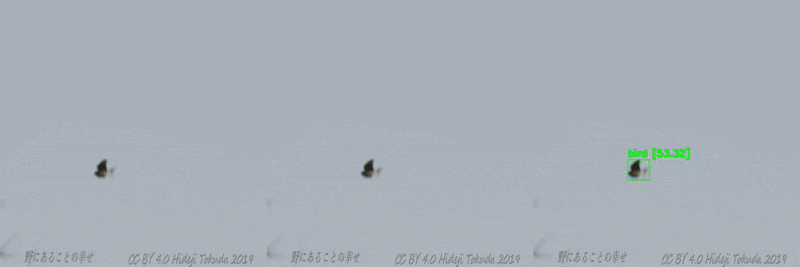はじめに
darknetでの実装とOpenCV DNNでの実装の比較を
Yolov3をDarknetとOpenCVのDNNで実行し速度比較で比較しました。
ここでは、YOLOv3 , YOLOv4 , YOLOv3-sppの速度と認識率? の比較をしてみました。
条件
測定環境
- XavierNXでnvpmodel -m 2で実施
- DarknetをDocker上で実施Jetson Xavier NX/JetsonNANOでDNN_BACKEND_CUDAが使えるOpenCV4.3をDockerでビルド+Darknetをビルド済みなXavierNX/JetsonNANOのDockerイメージを作成で作って実行したコンテナ上で実施
- Youtubeの野鳥のビデオを1/30にフレームを間引いたものを利用(詳細はYolov3をDarknetとOpenCVのDNNで実行し速度比較)
- 見つけた鳥の数、平均フレームレートを比較
- yolov4 とyolov3-spp はデフォルトの設定だとネットワークサイズが608x608になっているので、条件をそろえるためにyolov3と同じ416 x 416に変更して測定
手順
- docker 上でdv.py(後述)を利用してフレームレートと鳥の認識数を比較
- dv.py内のMODELとCFGをそれぞれに合わせて変更して測定
- *.cfgファイルのネットワークサイズを416x416にして測定
結果
| MODEL | FPS | Total no.of birds |
|---|---|---|
| YOLOv3 | 10.55 | 1260 |
| YOLOv3-SPP | 10.11 | 1414 |
| YOLOv4 | 8.45 | 1634 |
| フレームレートがYolov3をDarknetとOpenCVのDNNで実行し速度比較に比べ少しあがったのは、標準出力をteeにパイプしたことによる表示負荷の減少のためだと思います。 |
全フレームはみられないんので、カウンタに差がでたフレームのうちの頭の何フレームかチェックしたところ、
YOLOv3-SPP,YOLOv4は初めのルリビタキが首をひねっても鳥として認識しているのにもかかわらずYOLOv3は鳥と識別できていませんでした。
5/30アップデート
以下ビデオでやってみました、#クリエイティブコモンズライセンス
峠の鳥たち 信越の峠 9月中旬 野鳥4K 空屋根FILMS#1098
以下違いがでたフレームの抜粋です。#パフォーマンス試験したのとビデオが違います。元はライセンスの関係で中身をここに乗せられませんでした。
圧縮がかかって時がみにくいですが、左からyolov3 , yolov3-spp , yolov4です。
アノテーションは鳥以外もでてるので、それで違いがでてることもあります。

dv.py
from ctypes import *
import math
import random
import os
import cv2
import numpy as np
import time
import darknet
def convertBack(x, y, w, h):
xmin = int(round(x - (w / 2)))
xmax = int(round(x + (w / 2)))
ymin = int(round(y - (h / 2)))
ymax = int(round(y + (h / 2)))
return xmin, ymin, xmax, ymax
def cvDrawBoxes(detections, img):
found=0
for detection in detections:
x, y, w, h = detection[2][0],\
detection[2][1],\
detection[2][2],\
detection[2][3]
xmin, ymin, xmax, ymax = convertBack(
float(x), float(y), float(w), float(h))
pt1 = (xmin, ymin)
pt2 = (xmax, ymax)
cv2.rectangle(img, pt1, pt2, (0, 255, 0), 1)
cv2.putText(img,
detection[0].decode() +
" [" + str(round(detection[1] * 100, 2)) + "]",
(pt1[0], pt1[1] - 5), cv2.FONT_HERSHEY_SIMPLEX, 0.5,
[0, 255, 0], 2)
if detection[0]==b'bird':
found=found+1
return img,found
netMain = None
metaMain = None
altNames = None
def YOLO():
global metaMain, netMain, altNames
configPath = "./cfg/yolov3.cfg"
weightPath = "./yolov3.weights"
metaPath = "./cfg/coco.data"
if not os.path.exists(configPath):
raise ValueError("Invalid config path `" +
os.path.abspath(configPath)+"`")
if not os.path.exists(weightPath):
raise ValueError("Invalid weight path `" +
os.path.abspath(weightPath)+"`")
if not os.path.exists(metaPath):
raise ValueError("Invalid data file path `" +
os.path.abspath(metaPath)+"`")
if netMain is None:
netMain = darknet.load_net_custom(configPath.encode(
"ascii"), weightPath.encode("ascii"), 0, 1) # batch size = 1
if metaMain is None:
metaMain = darknet.load_meta(metaPath.encode("ascii"))
if altNames is None:
try:
with open(metaPath) as metaFH:
metaContents = metaFH.read()
import re
match = re.search("names *= *(.*)$", metaContents,
re.IGNORECASE | re.MULTILINE)
if match:
result = match.group(1)
else:
result = None
try:
if os.path.exists(result):
with open(result) as namesFH:
namesList = namesFH.read().strip().split("\n")
altNames = [x.strip() for x in namesList]
except TypeError:
pass
except Exception:
pass
# cap = cv2.VideoCapture(0)
cap = cv2.VideoCapture("output.avi")
maxFrame=cap.get( cv2.CAP_PROP_FRAME_COUNT)
print("maxframe=",maxFrame)
print("Starting the YOLO loop...")
# Create an image we reuse for each detect
darknet_image = darknet.make_image(darknet.network_width(netMain),
darknet.network_height(netMain),3)
fpsgt=0
frameTotal=0
foundTotal=0
while frameTotal < maxFrame-10:
prev_time = time.time()
ret, frame_read = cap.read()
frame_rgb = cv2.cvtColor(frame_read, cv2.COLOR_BGR2RGB)
frame_resized = cv2.resize(frame_rgb,
(darknet.network_width(netMain),
darknet.network_height(netMain)),
interpolation=cv2.INTER_LINEAR)
darknet.copy_image_from_bytes(darknet_image,frame_resized.tobytes())
detections = darknet.detect_image(netMain, metaMain, darknet_image, thresh=0.25)
image ,found= cvDrawBoxes(detections, frame_resized)
image = cv2.cvtColor(image, cv2.COLOR_BGR2RGB)
fps = 1/(time.time()-prev_time)
fpsgt = fpsgt + fps
frameTotal=frameTotal+1
foundTotal=foundTotal+found
print( "AVG FPS="+str(fpsgt / frameTotal) + " FRAME="+str(frameTotal)+" BIRD="+str(foundTotal)," ",frameTotal/maxFrame*100,"%complreted")
# cv2.imshow('Demo', image)
# cv2.waitKey(3)
cap.release()
# out.release()
if __name__ == "__main__":
YOLO()
フレーム確認方法(手作業。。。)
dv.pyからは
AVG FPS=9.889294695463574 FRAME=35 BIRD=31 3.43811394891945 %complreted
AVG FPS=9.904231780448072 FRAME=36 BIRD=32 3.536345776031434 %complreted
AVG FPS=9.912348439462216 FRAME=37 BIRD=33 3.6345776031434185 %complreted
AVG FPS=9.925056880049333 FRAME=38 BIRD=34 3.732809430255403 %complreted
AVG FPS=9.940727948116814 FRAME=39 BIRD=35 3.831041257367387 %complreted
AVG FPS=9.953403005960066 FRAME=40 BIRD=36 3.9292730844793713 %complreted
AVG FPS=9.966885726507298 FRAME=41 BIRD=37 4.027504911591356 %complreted
モデル毎にFRAMEの数字とBIRDの数字を比較することで食い違いがでたフレームが見つけれます。
一方フレーム毎の画像は以下のスクリプトで [FrameNo].jpgの形でセーブすることができるので、今の段階ではこの2つのデータから手で食い違いを確認しました。
import cv2
import numpy as np
import time
import darknet
def conv():
#cap = cv2.VideoCapture(0)
cap = cv2.VideoCapture("output.avi")
totalFrame = cap.get( cv2.CAP_PROP_FRAME_COUNT)
fnum=0
while fnum < totalFrame:
ret, outimage = cap.read()
cv2.imshow( 'read',outimage )
cv2.waitKey(1)
print( str( fnum / totalFrame *100)+"%")
fnum=fnum+1
cv2.imwrite( "jpg/"+str(fnum)+".jpg",outimage )
cap.release()
out.release()
if __name__ == "__main__":
conv()